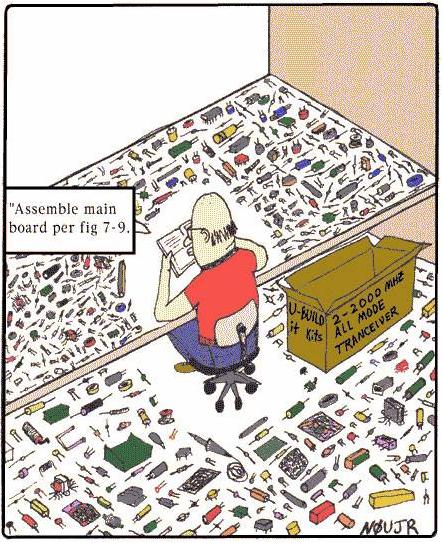
|
An Overview of the Molotora® Gontor® Full-Featured Radio By Robert W. Meister WA1MIK |

I've known of this old radio for quite a while and decided today is a good time to describe it to the radio community.
General Specifications:
The Molotora Gontor is based on the proprietary Gonkulator device that was first developed in Germany in the mid-1940s. It's a low-power radio (under 100 watts) that covers all frequencies you'd ever want to use it on, even mirror image, negative, and imaginary / complex frequencies. Type-accepted and type-approved cognitive recognition techniques allow it to demodulate all signals on all frequencies simultaneously. Its built-in variometer allows it to use any conductive material as an antenna, from full-length steel towers to wet, salty egg noodles. A Mallory Inductuner is used to electronically adjust the apple iPi network used in the transponder assembly. The radio also includes a highly accurate wattmeter that can measure forward, reflected, inner-conductor, outer-conductor, incidental, and re-radiated power. It will even measure power of other transmitters up to 30 feet away. The TBQ antenna connector will readily accept any size coax from RG174 to 6 inch hard-line. The radio's cover is held in place by several triple-bitted, five-sided locks, each keyed differently, one on each corner, assuring the ultimate in security. The radio can be trunk, dash, or console mounted, duct-taped under an airplane, or easily held in two hands.
But wait, there's more! If you read this within the next 10 minutes, we'll double your fun! The Gontor can even be used as a stand-alone repeater. It has a built-in Vari-gain, hybrid ring-tone, auto-tuning duplexer, based on the international Gld / Slvr / Brnz medallion technology. This allows it to handle any split or offset and still provide over 200dB isolation, making it ideal for law enforcement and public safety triplex operation. All voice transmissions made by users will be heard by anyone within earshot.
Transmitter and Receiver Capabilities:
It has the ability to simultaneously do Amplitude Modulation (AM) up to ± 150% symmetrical or asymmetrical depth, single, double, and triple sideband with suppressed or reduced carrier, Digital Modulation (DM) with all protocols, Frequency Modulation (FM) up to ± 200 kHz deviation, and even Phase Modulation (PM) up to ± 365 degrees, so it's compatible with all existing one-way, two-way, and three-way radio equipment made by GE, Motorola, Yaesu, Kenwood, Johnson, Icon, Alinco, etc. Privacy-Plus, SecureNet, Trunking, LTR, DMR, ZOWIE, TRBO, GRBL, APCO, P25, SPECTRE, and secure 512-bit encryption protocols are fully supported, however the radio is not certified for use outside this country, due to the Remulak zurls and other software patents. CW is sent with true carrier on/off (high-voltage) switching, and a spark-gap filter removes all chirp and other desirable signals. A Variolosser circuit maintains the level under all conditions.
The frequency response of both the transmitter and receiver is 0.1 Hz to 100 kHz, so it can easily handle sub-audible (PL, CTCSS, DPL, or DCS) coding schemes as well as audible tone signaling (DTMF, tone-burst, noise-burst, etc). It can even encode and decode any and all of these simultaneously. The built-in DTMF decoder handles all 17 possible two-tone digits. It can also handle pulse dialing and SELCAL decoding at up to 100 Baud. A seven-speed Borg-Warmer transmission handles Baudot and ASCII data formats. Tall, blond, and handsome audio inputs are provided for easy wireless-line integration into any existing communications system. A GPS-disciplined, micro-miniature, cesium beam master oscillator insures the radio will be on any frequency at all times. The patented Merkeljammer circuit uses PermaQuay filters to remove all pulse-type noise interference picked up by the receiver. A heuristic audio filter will even mute the audio and retune the receiver to something better, when unintelligent signals (or lids) are encountered.
Reproductive Devices:
The built-in three-way speaker faces all directions equally well and easily reproduces everything the receiver can hear, including noise and all variations of repeater courtesy tones, beeps, grunts, twangs, burps, etc. For those acoustically-challenged owners, an external 6,000 watt-per-channel amplifier is available from Crown International. See the 200kB PDF file data sheet here. The rare-earth, liquefied, natural unobtanium microphone will pick up all noises emanating from your body. It has a built-in "release-to-listen" button that doesn't violate the often-duplicated and patented "Push-To-Talk" system, allowing royalty-free use of every bit of electromagnetic spectrum. That well-known German scientist, Dr. Ruth Westheimer, seductively designed these two devices for maximum pleasure and enjoyment from your QSO partner. The neon-colored "Magic-Eye" tuning indicator automatically displays receive and transmit audio levels and the direction they came from, and can be configured to display slow-scan, fast-scan, analog, or digital video signals. The MPEG5000 decoder can handle no-def, high-def, noun, verb, and synonym signals. A separate satellite receiving antenna (with down-converter) and universal decoder can also be attached. I have also heard rumors about a universal translator option (SP-UFP), but I have no idea why anyone would need that in this day and age. Of course, smart-phone and RedFang connectivity are included at no extra cost.
Miscellaneous Details and Features:
The rear-panel display uses 9-character nixie tubes (the digits 6 and 9 use the same pattern but are shown in complementary colors). The front panel is ergonomically designed and each of the unlabeled buttons activates a random function. This ensures maximum enjoyment out of the radio. The user manual, when it was available, cost a mere $3,500AU. It is, unfortunately, no longer available. I could post a PDF copy, but it's a big file, nearly 100TB, so you'll need a high-speed sub-space connection to even think about downloading it, plus it would violate all copyleft regulations.
An optional packet and expedition cluster detector is available. It will display the transmit, intermediate, and receive frequencies of all distant contest stations. APRS is automatically provided with the radio's exact location thanks to the built-in GPS receiver. The user's call sign is automatically recognized and included in every location report.
Standard DC, IR and tone remote control is built in, using twist-lock XLR connectors, arranged in an aneroid pattern. There's even a phone patch with a comprehensive feedback and echo elimination system and an automatic "under" detector.
Programming and Power Options:
The radio is programmed using a Teletype Model 15 (Baudot) machine with a 130V, 60mA D.C. current loop interface, however only the numbers 2 through 9 are accepted for frequency input. Ordinary HTML codes are used, so you don't need to steal proprietary programming software or even obtain an RSS license, which is necessary for some other radios. Just like your luggage, the combination code "12345" must be entered as the device access code. The programming data is stored in a Signetics 25120 EEPWOM chip so you won't forget it. See the 80kB PDF file data sheet here.
Unlike most of the Japanese radios that limit your labels to perhaps eight characters, you can label each channel in the Gontor by using up to 99.4% of available memory. An easily replaced 67.5V "B" battery provides memory retention for the life of the battery or the original owner, whichever expires last. An optional -22.5V "C" battery provides negative bias voltage for those users who like to have a lot of political conversations. A built-in 33VDC voltage-doubling, electron-coupled (no ground required) power converter allows wireless vehicular operation. This is far more universal than the railroad radios ever offered.
A Jedi-compatible accessory connector can be configured to charge a second-generation light epee, ensuring that darkons are eliminated from nearby fluorescent tubes.
Alternator and power line noise is completely eliminated by a 4.7TF, Faraday shielded, water-soluble flux capacitor. This is coupled to the audio circuit's Eustachian tubes for maximum intelligence.
Photographs:

I'd love to provide a better photo but every time I try to take one using the camera's flash, the radio changes color and the front panel lettering moves around. I do have a picture of someone doing the engineering work on this radio though:

Newly-Discovered Features and Options:
To bring this unit into the 21st century, the manufacturer has added Blew-Tuuth connectivity for you and a dozen of your closest friends. Any compatible device within several miles will automatically be authenticated to allow full-triplex communication. No need to use that local repeater as an intercom system.
An iPod-like audio and video transcription device with seven zettabytes of storage allows you to save and replay several lifetime's worth of conversations, idle chit-chat, woodpecker interference, and 75-meter jamming, using a proprietary 666-bit security and self-correcting parity algorithm based on the nine's complement number system.
A touch-sensitive screen, running the latest Doors operating system software, is also available. Unlike the more popular Windows system, Doors doesn't need to be updated and/or rebooted every month; just leave it ajar and it takes care of itself by periodically slamming all nearby telephones. Using the keypad application, you can enter important information, which can be sent to other Gontor users at the speed of sound, saving your precious shared cellphone minutes for your teenagers to waste while driving.
The central computer system is controlled by three primary main processing cores, cross-linked with a redundant melacortz ramistat composed of fourteen kiloquad interface modules. The core element is based on an FTL nanoprocessor with 25 bilateral kelilactirals, with 20 of those being slaved into the primary heisenfram terminal. The isopalavial interface controls the main firomantel drive unit, which controls the ramistat core and also keeps the ontarian manifold at 40,000 KRGs. The ramistat kiloquad capacity is a function of the square root of the intermix ratio times the sum of the plasma injector quotient.
Credits and Acknowledgements:
Molotora, Gontor, PL, DPL, and a bunch of other terms might be trademarks of their respective companies. They have been used without permission. Do you think I really care about copyrights or copylefts?
This radio was eventually used as the basis for the Gonset Communicator and the Motorola Syntor.
The Motorola logo is commonly called a batwing. The Molotora logo can therefore be officially called a dingbat. Bats do hang upside down in caves and belfrys. Belfrys have bells. Bells go ding. QED.
This article has been carefully checked for spelling and grammatical errors. There are none. If you think you found a mistake, just keep reading it until it makes sense. Just like Microsoft technical support, everything stated herein is absolutely correct but completely useless.
The United States Department of Extreme Mismanagement and Homeland Insecurity and the Federal Candy Company approved the release of this information.
Contact Information:
The author ignores all e-mail. He cannot be contacted at: his-callsign [ at ] com-crap [ dot ] net
This page publicized on Thursday 32-Mar-2010 2400 local time.
Article text, artistic layout, photographs, and hand-coded HTML © Copyright 2010, 2011, and 2019 by Robert W. Meister WA1MIK.
This web page, the information presented in and on its pages and in these modifications and conversions is Copyright © 2010 by the author. All Rights are Reserved, including that of paper and web publication everywhere and anywhere. The web site owner has no right to distribute this anywhere else. Permission will not be given to have it hosted elsewhere. In fact, no one has permission to even read this article.